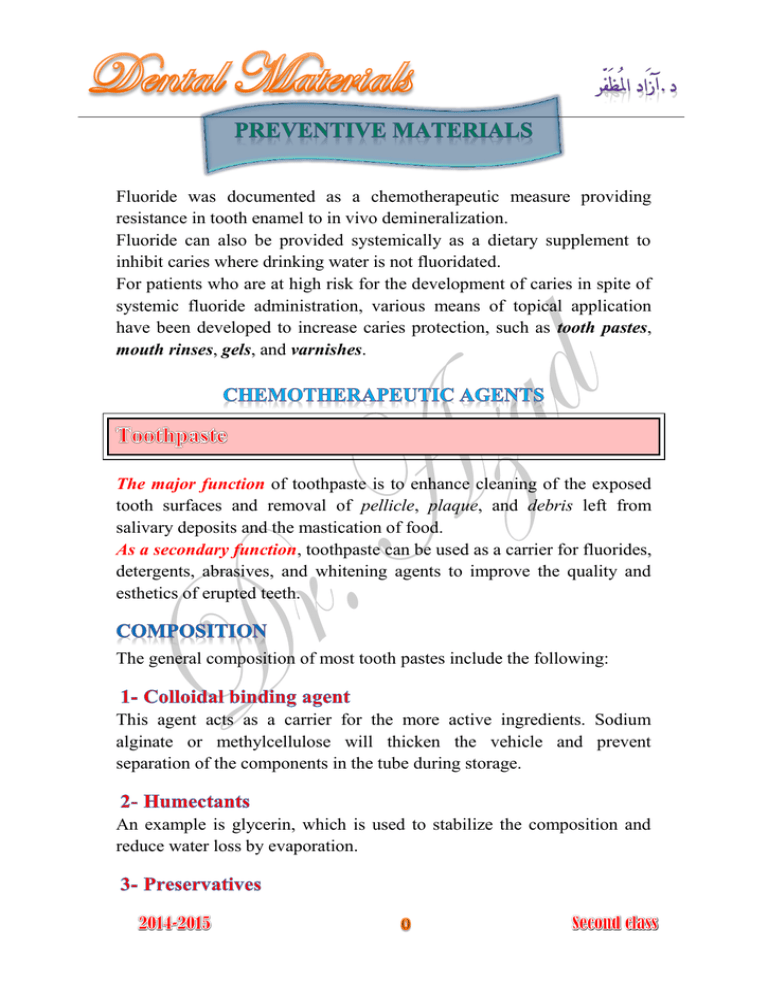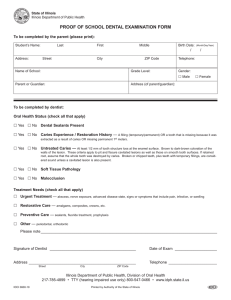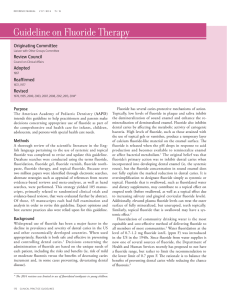Document 12524972
advertisement

Fluoride was documented as a chemotherapeutic measure providing resistance in tooth enamel to in vivo demineralization. Fluoride can also be provided systemically as a dietary supplement to inhibit caries where drinking water is not fluoridated. For patients who are at high risk for the development of caries in spite of systemic fluoride administration, various means of topical application have been developed to increase caries protection, such as tooth pastes, mouth rinses, gels, and varnishes. The major function of toothpaste is to enhance cleaning of the exposed tooth surfaces and removal of pellicle, plaque, and debris left from salivary deposits and the mastication of food. As a secondary function, toothpaste can be used as a carrier for fluorides, detergents, abrasives, and whitening agents to improve the quality and esthetics of erupted teeth. The general composition of most tooth pastes include the following: This agent acts as a carrier for the more active ingredients. Sodium alginate or methylcellulose will thicken the vehicle and prevent separation of the components in the tube during storage. An example is glycerin, which is used to stabilize the composition and reduce water loss by evaporation. Preservatives are used to inhibit bacterial growth within the material. Peppermint, wintergreen, and cinnamon are added to enhance consumer appeal and to combat oral malodors. Abrasives are incorporated into all pastes to aid in the removal of heavy plaque, adhered stains, and calculus deposits. Calcium pyrophosphate, dicalcium phosphate, calcium carbonate, hydrated silica, and sodium bicarbonate are used in varying amounts to obtain this effect. An example is sodium lauryl sulfate, which is used to reduce surface tension and enhance the removal of debris from the tooth surface. The use of stannous fluorides has been demonstrated effective in the uptake of the fluoride ion and improved resistance of fluorapatite to acid demineralization in the initiation of carious lesions. Minor miscellaneous ingredients are included to reduce tube corrosion, stabilize viscosity, and provide pleasing coloration. Minor amounts of peroxides are included in some pastes, with marketing claims that they will remove innate discolorations and improve esthetics. Mouthwash is a liquid solution that is applied as a rinse on a regular basis to enhance oral health, esthetics, and breath freshening. Mouthwashes are most effective when applied in the morning or the evening following mechanical cleansing of the tooth surfaces with a brush and toothpaste. Mouthwashes are composed of three main ingredients. 1- An active agent is selected for a specific health care benefit, such as anticaries activity (fluoride), antimicrobial effect (Chlorhexidine 0.1% and 0.2%), and reduction of plaque adhesion. 2- Surfactants are also added to most mouthwashes to help remove debris from the teeth and dissolve other ingredients, like sodium lauryl sulfate. 3- Flavoring agents added for breath freshening include eucalyptol, menthol, thymol, and methyl salicylate. Fluoride containing varnishes provide an additional means of delivering fluoride topically to the surfaces of teeth in patients at risk for caries. The one advantage of the varnish mode of application is the extended time of exposure for the active fluoride ingredient against the tooth surface; it may be hours before a varnish wears off, instead of seconds, as with a mouthwash. Pits and fissures in the occlusal surfaces of permanent teeth are particularly susceptible to decay, and fluoride treatments have been least effective in preventing caries in these areas. Figure (8-1): Pack of fissure sealant material which is similar in composition to the enamel bonding agent. The most common sealants are based on Bis-GMA resin and are light cured, although some self-cured products are still available. Also Glass Ionomer sealants are available. Figure (8-2): Flowable composite. The wettability of the enamel by the sealant is improved by etching (with a solution or a gel of 35% to 40% phosphoric acid), and some advocate pretreatment with silanes in a volatile solvent. The sealant may best be applied with a thin brush, a ball applicator, or a syringe. Take care to avoid the buildup of excess material that could interfere with developing occlusion. The use of athletic mouth protectors in contact sports has increased rapidly; they are routinely used in football, soccer, ice hockey, basketball, wrestling, field hockey, softball, and other sports. Injuries to teeth from trauma caused by athletic activity have involved pulpitis, pulpal necrosis, resorption, replacement resorption, internal hemorrhage, pulp canal obliteration, and inflammatory resorption. The fabrication of a custom-made mouth protector involves the following general steps: Making an alginate impression of the maxillary arch. Pouring a dental stone or high-strength stone model into the impression, minus the palate. Vacuum-forming a heated thermoplastic sheet. Trimming the excess around the model. Smoothing the edges of the mouth protector. Figure (8-3): Typical vacuum-forming machine. In addition to athletic mouth protectors, vacuum forming is used to prepare trays for impression materials, fluoride treatments, bleaching procedures, surgical splints, and orthodontic retainer. L K Figure (8-4): Illustration showing the essential parts: A: the sheet of mouth protector material. B and K: upper and lower clamp that hold the sheet. D: the cast is centered on (E) the perforated support plate. F: the heater. H: switch. I: the heating continued until the sheet sags about 3 cm. G: the vacuum switch. When the vacuum switch turned ON, the heated sheet is quickly lowered over the cast using the attached plastic handles (C). The sheet is vacuum-sealed to the support plate via the perforations and is then vacuum-formed over the cast. The heater is turned OFF and swings away 90 degrees using the attached handles (L). The vacuum is turned OFF after 30-60 seconds. The vacuum-formed mouth protector remains on the cast until cool and then trimming and finishing.






